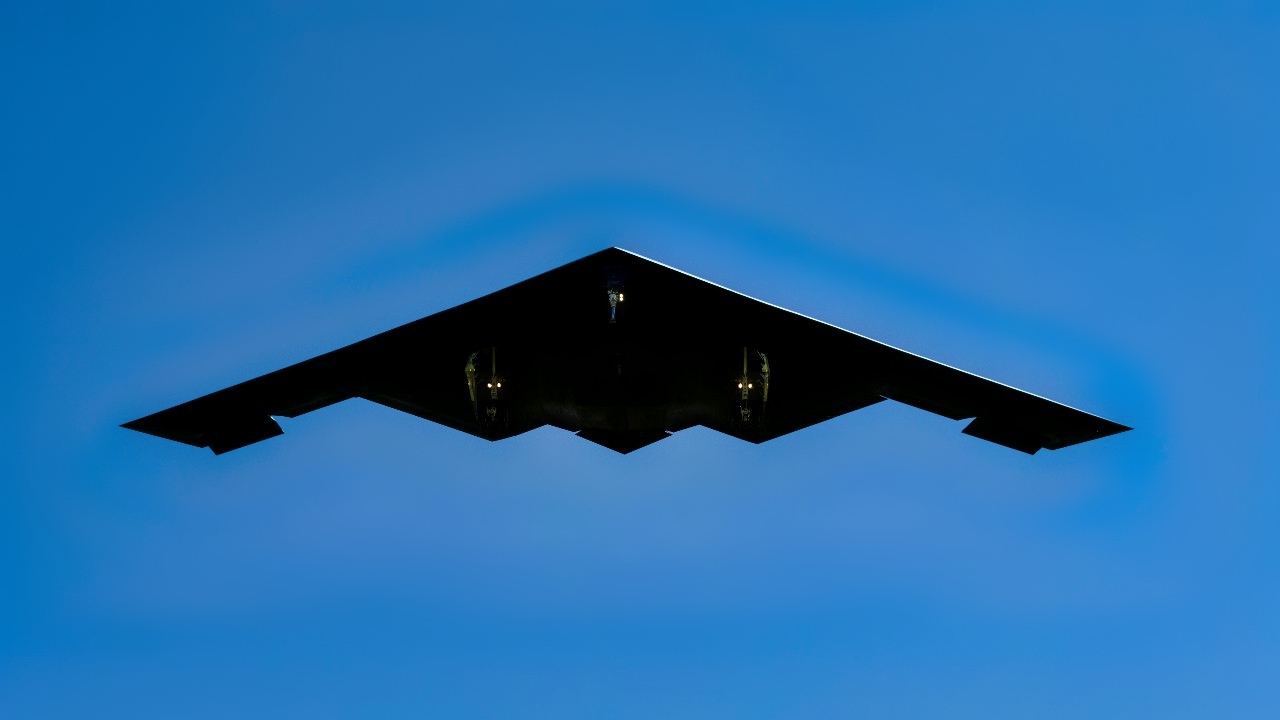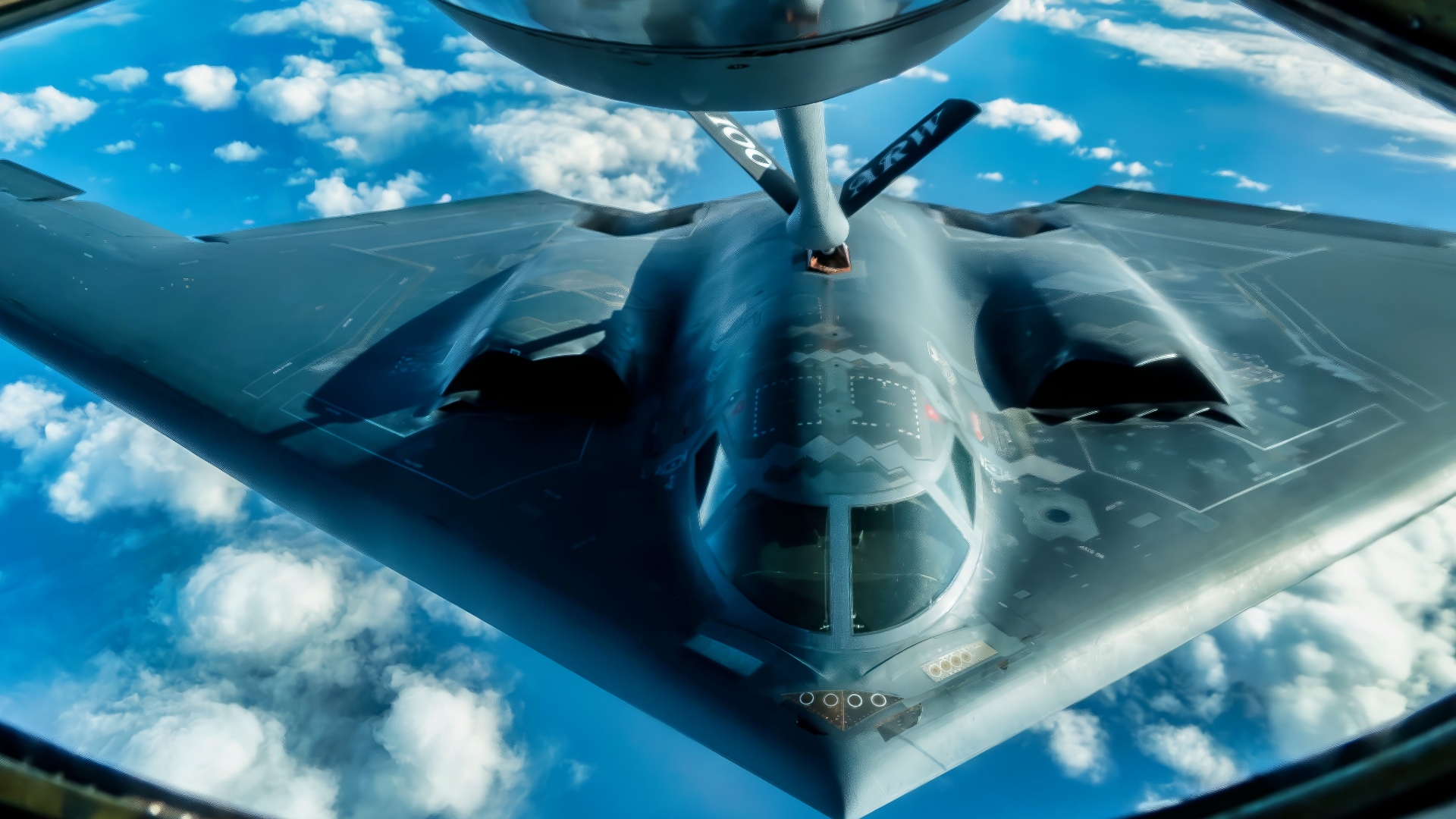Key Points and Summary – In February 2008, the B-2 “Spirit of Kansas” crashed seconds after takeoff from Andersen AFB, Guam, in what became the most expensive aviation accident in history.
-Hidden moisture in the bomber’s air data sensors fed bad information to its flight-control computers, triggering an abrupt 30-degree pitch-up, stall, and runway impact.

A B-2 Spirit soars after a refueling mission over the Pacific Ocean on Tuesday, May 30, 2006. The B-2, from the 509th Bomb Wing at Whiteman Air Force Base, Mo., is part of a continuous bomber presence in the Asia-Pacific region. (U.S. Air Force photo/Staff Sgt. Bennie J. Davis III)
-Both pilots ejected, but the $1.4 billion aircraft was lost, and the entire B-2 fleet was temporarily grounded.
-With only 21 Spirits ever built—and just 12–14 typically combat-ready—the crash underscored how fragile America’s stealth bomber force is and why the Air Force is racing to field the B-21 Raider.
The B-2 Spirit Crash in Guam in 2008
The U.S. Air Force B-2 Spirit is a heavy strategic bomber with low-observable stealth technology designed to penetrate dense anti-aircraft defenses. Designed by Northrop Grumman, it has a subsonic flying wing and a crew of two. It was produced from 1987 to 2000.
The bomber can drop conventional and thermonuclear weapons, including up to eighty 500-pound class Mk 82 JDAM GPS-guided bombs, or sixteen 2,400-pound B83 nuclear bombs. The B-2 is the only acknowledged in-service aircraft that can carry large air-to-surface standoff weapons in a stealth configuration.
There have been two major B-2 bomber crashes in recent history: a 2008 crash in Guam caused by sensor data issues, and a 2022 crash at Whiteman Air Force Base in Missouri due to a hydraulic system failure during an emergency landing.
The 2008 crash was the most expensive aviation accident in history, destroying a $1.4 billion aircraft. In the 2022 incident, the $2 billion “Spirit of Hawaii” was retired after being deemed too expensive to repair; there were no injuries to the crew.
The 2008 Crash At Andersen AFB in Guam
On Feb. 23, 2008, “The Spirit of Kansas,” B2 89-0127, crashed on the runway shortly after takeoff from Andersen Air Force Base in Guam. The crash of the bomber, which had been operated by the 393rd Bomb Squadron, 509th Bomb Wing, Whiteman Air Force Base, Missouri, and had logged 5,100 flight hours, was the first crash of a B‑2 stealth bomber.
The two-officer crew (Major Ryan Link and Captain Justin Grieve) was unable to control the bomber. As one of its wingtips made contact with the ground, they ejected and survived the crash. The aircraft was destroyed. The $1.4 billion loss was equivalent to approximately $2 billion in 2024.
At Guam Naval Hospital, one pilot was evaluated and released, and the second was hospitalized for a spinal compression fracture. A B‑2 already in the air was called back to Andersen, where it and the other B‑2s were grounded until the initial investigation into the crash was complete. Six B‑52s of the 96th Bomb Squadron, 2nd Bomb Wing at Barksdale Air Force Base, Louisiana, were deployed to replace them.

A US. Air Force B-2 Spirt assigned to the 509th Bomb Wing, Whiteman Air Force Base receives fuel from a U.S. Air Force KC-135 assigned to the 185th Air Refueling Wing, Iowa Air National Guard in the sky over northwest Missouri on August 29, 2018.
U.S. Air National Guard photo by Senior Master Sgt. Vincent De Groot
The commander of the 509th Bomb Wing, Brig. Gen. Garrett Harencak, temporarily suspended flying operations for all 20 remaining B‑2s to review procedures. Harencak termed the suspension a “safety pause” and stated that the B‑2s would resume flying if called upon for immediate operations. The B‑2 fleet returned to flight status on April 15, 2008.
Accident Investigation, Mother Nature Strikes Again
The investigation found the B-2 crashed after “heavy, lashing rains” caused moisture to enter the skin-flush air data sensors. The data from these sensors is used to calculate numerous factors, including airspeed and altitude.
Distorted data introduced by a B-2 Spirit’s air data system skewed information entering the bomber’s flight control computers, ultimately causing the crash of the aircraft on takeoff, according to an Air Combat Command (ACC) accident investigation report released on June 5, 2008.
Moisture in the aircraft’s Port Transducer Units during air data calibration distorted the information in the bomber’s air data system, causing the flight control computers to calculate an inaccurate airspeed and a negative angle of attack upon takeoff. According to the report, this caused an “uncommanded 30 degree nose-high pitch-up on takeoff, causing the aircraft to stall and its subsequent crash.”
The ACC accident report added that “classified material” had been loaded onto the bomber the morning the aircraft was returning to Whiteman AFB “after a four-month deployment in support of Pacific Air Forces’ continuous bomber presence.”
Because three pressure transducers failed to function—attributable to condensation inside devices, not a maintenance error—the flight-control computers calculated inaccurate aircraft angle of attack and airspeed. Incorrect airspeed data on cockpit displays led to the aircraft rotating 12 knots slower than indicated.

B-2 Bomber. Image Credit: Creative Commons.
After the wheels lifted from the runway, which caused the flight control system to switch to different control laws, the erroneously sensed negative angle of attack caused the computers to inject a sudden, 1.6 g uncommanded 30-degree pitch-up maneuver. The combination of slow lift-off speed and the extreme angle of attack, with attendant drag, resulted in an unrecoverable stall, yaw, and descent.
Both crew members successfully ejected from the aircraft soon after the left wing tip started to gouge the ground alongside the runway. The aircraft hit the ground, tumbled, and burned after its fuel ignited.
Meet The B-2 Spirit
The B-2 Spirit stealth bomber is a flying-wing design; it has no fuselage or tail. It can carry 40,000 pounds of munitions inside two internal weapons bays. Originally, it could drop 16 Joint Direct Attack Munitions (JDAMS). The Air Force later improved the hard point design in the bomb bays, and the B-2 can now carry up to 80 JDAMs.
The B-2’s flying-wing design and radar-absorbing materials were intended to dramatically reduce the aircraft’s radar cross section compared to conventional bombers and make it exceedingly difficult to detect and track
The B-2 is powered by four General Electric F118-GE-100 non-afterburning turbofans, each producing 19,000 pounds of thrust. Its maximum speed is 630 miles per hour at 40,000 feet altitude, and Mach 0.95 (729 mph) at sea level. Cruise speed is 560 mph at 40,000 feet altitude. The B-2’s range is 6,900 miles without inflight refueling.
Today, there are only 19 B-2s left.
B-2 Spirit Loss, USAF Can’t Tolerate The Loss Of a Single One
The U.S. stopped production of B-2 bombers after 21 were built, because of a combination of soaring costs, the end of the Cold War, and political pressure. The initial plan was to build 132 aircraft.
After the collapse of the Soviet Union, the B-2’s primary mission was eliminated, and immense budget pressures, exacerbated by the bomber’s extremely high per-aircraft cost, led to the drastic reduction.

A B-2 Spirit returns to Whiteman Air Force Base, Missouri, from a deployment to Diego Garcia, British Indian Ocean Territory, May 9, 2025. The B-2 is capable of penetrating heavily defended air spaces and delivering conventional and nuclear munitions anywhere on the globe. (U.S. Air Force photo by Master Sgt. Kenneth W. Norman)

A B-2 Spirit bomber, deployed from Whiteman Air Force Base, Missouri, is staged on the flightline at Joint Base Pearl Harbor-Hickam, Hawaii, Jan. 25, 2019. Three B-2 Spirit stealth bombers and more than 200 Airmen deployed here in support of U.S. Strategic Command’s Bomber Task Force (BTF) mission. During the BTF mission 37 sorties were flown for a total of 171 hours, with eight of the missions including F-22 Raptor integration. (U.S. Air Force photo by Senior Airman Thomas Barley)
That decision, much like the decision to stop building the F-22, has proved to be short-sighted. The B-2 fleet is too small to meet all demands placed upon it, and the loss of a single one is considered intolerable by the Air Force.
Not all B-2s are available for combat at any time. Typically, at least one is in long-term depot maintenance at Northrop, while two or three more are in heavy maintenance at Whiteman. Meanwhile, up to two are in flight testing at Edwards Air Force Base, California. The Air Force has stated that it typically has 12-14 B-2s available for combat.
The B-2 Will Soon Be Replaced
The development of the B-21 Raider echoes that of its predecessor. Like the B-2, the B-21 is a flying-wing-type strategic stealth bomber. However, its stealth capabilities are believed to be significantly more advanced than those of the B-2, thanks to modern materials, improved avionics, and advances in other flight systems.
“The U.S. Air Force has stated plans to acquire at least 100 aircraft. Some defense analysts believe that the Air Force should plan to purchase at least 200 B-21s,” according to Northrup Grumman.
Although the B-21 Raider is the future, the B-2 remains very much a part of the present. It is the tip of the spear for American penetration bombing missions against its enemies.
About the Author: Steve Balestrieri
Steve Balestrieri is a National Security Columnist. He served as a US Army Special Forces NCO and Warrant Officer. In addition to writing on defense, he covers the NFL for PatsFans.com and is a member of the Pro Football Writers of America (PFWA). His work was regularly featured in many military publications.
More Military
The U.S. Navy’s Constellation-Class Frigate Crisis Keeps Getting Worse
China’s New H-20 Stealth Bomber Might Have a 10,000 km Range
Even Mach 3 Speeds Could Not Save the Titanium SR-71 Blackbird
The U.S. Navy’s New DDG(X) Destroyer Is Sailing Into Stormy Waters










